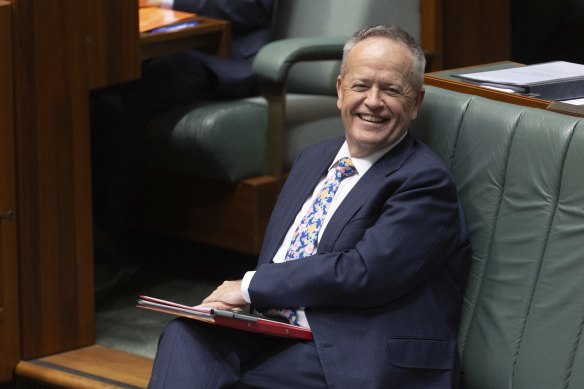This was published 9 months ago
More children start exiting NDIS as scheme shows signs of slowing
Children are exiting the National Disability Insurance Scheme in growing numbers and 25,000 fewer Australians joined this financial year than the one before, in signs Bill Shorten’s reforms to the $42 billion program could start to slow its steep growth curve.
The latest NDIS quarterly report reveals scheme spending for 2023-24 came in $600 million below the budget estimate. The number of new participants grew 8 per cent but dropped below a double-digit increase for the first time in years.

NDIS Minister Bill Shorten in Canberra on Tuesday.Credit: Alex Ellinghausen
The signs of moderation come as Shorten, the NDIS minister, seeks to push through major changes to the scheme that will temper growth further, including by limiting the type of support people can access. He faces a backlash from state premiers and disability advocates, although he is closer to securing Coalition support to get his bill through the Senate.
The new list of NDIS “in and outs”, which is open for public consultation this month, clarifies that daily living costs such as rent, household items, insurance costs, petrol and groceries should not be funded by the scheme. Lifestyle purchases such as alcohol, gambling, cigarettes, toys, sex work, clothing, beauty services and holidays will also be ruled out.
It also makes clear that mainstream health services – such as diagnostic assessments, pharmaceuticals and palliative care – should be funded outside the scheme, as should treatments for addiction or eating disorders. Similarly, education costs such as school fees, teaching aids or learning supports that focus on education, textbooks and school refusal programs will not be the responsibility of the NDIS.
The support list is one of several major changes Shorten wants to introduce, in addition to new needs assessments, longer plans and capped budgets that have strict limits on how much funding can be spent annually, with the money released in intervals.
The reforms act on last year’s NDIS review and are designed to limit the scheme to an 8 per cent growth trajectory by 2026. It has previously grown at up to 20 per cent a year, making it one of the federal budget’s biggest expenses.
The latest quarterly report shows signs that growth is moderating.
“I welcome the NDIS investment coming in $600 million less than was forecasted and provisioned for,” Shorten said.
There were 50,765 extra Australians on the NDIS in June this year than the year before, taking the total number to 661,267. This represented a fall in participant growth from the year before, when there were 75,847 additional people on the scheme.
The proportion of five- to seven-year-old children using the NDIS – the biggest age group as a share of the population and one of the fastest growth areas – also remained stable over the past six months, at 12.4 per cent of boys and 5.6 per cent of girls in that age group.
Last year, the proportion of young children on the scheme grew by as much as 1 percentage point in three months.
The agency attributed the stabilising figures to more children than usual leaving the scheme, as well as a higher number of participants exiting in general.
“More participants, especially those on the early childhood pathway, are seeing the benefits of early intervention,” the report said.
“Of the participants who have left the NDIS, some have built capacity through their NDIS supports and are living a more independent life, while others are continuing to receive supports from outside the scheme.”
It also said people were changing their spending as the agency had started proactively contacting people who appeared at risk of exceeding their plan limits.
The latest data bodes well for Shorten, who has invested his political capital in dampening the scheme’s growth so it does not blow out to a forecast $100 billion within a decade.
But disability advocates have argued his restrictions could make it harder for people to get the support they need, while state governments are nervous about being on the hook for billions more in disability spending.
Shorten said this week he understood the disability sector was anxious about change.
“They have muscle memory,” he said. But he said no other country made the per capita investment in disability that Australia did.
“I want this scheme to be here in the future. So going to this issue of ripping off the Band-Aid, I will do just about everything to try to convince the states to like what we’re doing,” he said.
Shorten said he was having constructive discussions with the Coalition and working on amendments that could guarantee its support for the legislation.
Cut through the noise of federal politics with news, views and expert analysis. Subscribers can sign up to our weekly Inside Politics newsletter.